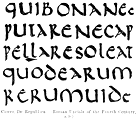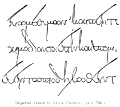Palaeography
(from
παλαιός+
γράφειν).
The science which has to do with the study of ancient manuscripts, comprising their
decipherment, and the determination of their date, genuineness, and origin. Strictly speaking,
palaeography deals only with the external characteristics of a codex, while the study and
criticism of its internal characteristics fall under the general department of Textual
Criticism. (See
Textual Criticism.)
Palaeography also differs from epigraphy in being concerned with writings upon leather,
papyrus, vellum, and other soft substances, while epigraphy treats of writing engraved upon
stone, metal, etc. See
Epigraphy.
 |
|
Papyrus of Artemisia. (Third Century, B.C.)
|
The oldest existing manuscripts are the papyri found in the Egyptian tombs, the most ancient
of all being the so-called Papyrus Prisse, which is the oldest book in the world, dating from
the eleventh dynasty, and therefore earlier than the date at which the Book of Exodus was
composed. The oldest classical manuscript is the papyrus containing the Greek text of the
Antiope of Euripides, which dates from about the second century B.C. See
Papyrus, p. 1173.
The subject matter of palaeography is the
 |
|
Herondas. (Uncials of the Third Century, B.C.)
|
substance on which the writing was done and the instruments which the writers used. The
writing materials were papyrus (
πάπυρος), early used in
Egypt; skins of animals, used by the Egyptians as early as the fourth dynasty and by the
Greeks (
Herod.v. 58); parchment and vellum (
διφθέραι,
membrana Pergamena), used by both Greeks and Romans
(Boissonade,
Anecd. i. 420;
Ad Att. xiii. 24; Martial, xiv. 184
and 186); and paper made of the cotton-plant (
ξυλοχάρτιον,
 |
|
Receipt in Greek Cursive. (A.D. 20.)
|
ξυλότευκτον,
charta bombycina, gossypina,
Damascena), first imported from the East by the Greeks, but hardly used before the
twelfth century A.D. (
Sched. Divers. Artium, i. 24, ed. Hendrie). The
implements used for writing on these substances were the reed-pen (
κάλαμος, δόναξ γραφεύς, σχοῖνος,
calamus, canna), the use
of which survived in Italy to the thirteenth century; the brush (
κονδίλιον,
peniculus, penicillus), used for writing in gold;
and the quill-pen (
penna), not mentioned before the fourth century
(Ammian. Marcell.
Excerp. ed. Gronovius, p. 512, 1693;
Orig. vi. 13).
Ink, usually black, but sometimes brown, red, and purple, and in the Middle Ages green,
yellow, etc., was called
μέλαν or
γραφικὸν μέλαν, μελάνιον,
atramentum (
librarium), and
incaustum. Red ink was
μελάνιον κόκκινον,
minium, rubrica. Gold writing-fluid and
(rarely) silver ink were used in ornamentation. Other collateral implements were the ruler
(
κυκλοτερὴς μόλιβδος,
regula), the
knife-eraser (
rasorium, novacula), the pen-knife (
σμίλη,
scalprum librarium), and pricker or compass (
διαβάτης,
circinus). For the removal of recent
writing, a sponge was used (Martial, iv. 10). A pointed piece of lead (
μόλυβδος,
plumbum) performed the office of the modern
lead-pencil. See
Circinus;
Codex;
Papyrus;
Writing and Writing
Materials.
The earliest form of manuscript was the roll. For full details, see
Liber. From the manuscript, the writing was often erased to make room for
new matter. In this case it was called a palimpsest (
παλιμψηστος). See
Palimpsest.
The copyists of the manuscripts (
γραμματεῖς,
scribae) were in classical times usually slaves especially trained; in the Middle
Ages, monks. For short-hand writers (
notarii), see
Notae.
There are four sorts of Greek writing: capitals, uncials, cursives, and minuscules. The
capitals are found chiefly in manuscripts, in letters and initial letters. The uncials are the
most common form of letters in ancient books, and resemble the modern capital. The breathings
and accents are generally omitted, and the iota subscript is written by the side of its
vowel—at the right. The cursive was gradually developed out of the uncial, from which it differed more and more. It is found in manuscripts of the
second century B.C. and as late as the seventh century A.D. Minuscules prevail after the ninth
century A.D.
 |
|
Latin Poem on the Battle of Actium. (Before A.D. 79.)
|
There are also the same four varieties of writing in Latin manuscripts. The capitals appear
in a poem by Rabirius (?) on the battle of Actium found at Herculaneum, in the Vatican and
Florence Vergils, and in the Paris Prudentius. The uncials, which are distinguished by the
rounded forms of the letters (especially U), were perfected in the fourth century A.D. and
lasted till the ninth. The Veronese palimpsest of Livy is in uncials. There are many specimens
of the Roman cursive in the
graffiti of Pompeii (see vol. iv. of the
Corp. Inscrip. Lat.) and elsewhere. It varied at different periods, and gave
rise to different mediæval forms of writing—e. g. the Lombardic,
Visigothic, etc. The Roman minuscules were not developed until the end of the eighth century
A.D.
 |
|
Pompeian Wall Inscription. (First Century, A.D.)
|
in the school of Alcuin, and reached their perfection in the twelfth century. They
are the source of the earliest Italic characters. If a Latin manuscript is wholly in capitals,
it is earlier than the eighth century; and when the words are not spaced it is earlier than
the seventh. Stiff, upright characters denote a late date. The uncial writings are usually
earlier than the eighth century; the minuscule prevails after the ninth; a great number of
abbreviations indicates the eleventh century. If a text is written in cursive that has great
facility in its ligatures, it is presumably antique. See
Alphabet.
The greatest difficulty in deciphering manuscripts comes from the contractions,
abbreviations, and ligatures which they contain. Thus, the copyists in mediæval
France used more than 5000 forms of contraction. The following are a few that are common, and
hence may serve as illustrations:
qm=quum or
quoniam;
qūō=quomodo; .n.=enim;
=
est; o[mtilde]s=omnes; hõiñ=hominum;
āūt=autem; ā=annos; p=
prae; pp.=
prope.
 |
|
Cicero, De Republica. (Roman Uncials of the Fourth Century, A.D.)
|
Some of the mediæval abbreviations we still find in common use, as
e. g. for
exempli gratia; i. e. for
id
est; viz. for
videlicet.
Bibliography.—See Gardthausen,
Griechische
Paläographie (Leipzig, 1879); Wattenbach,
Anleitung zur
griechischen Paläographie (Leipzig, 1877); id.
Anleitung zur lateinischen Paläographie (4th ed. Leipzig,
1886); Chatelain,
Paléographie des Classiques Latins (Paris,
1884, still appearing); the monograph “Paläographie,” by Blass,
in Iwan Müller's
Handbuch (2d ed. Munich, 1892); Wailly,
Éléments de Paléographie, 2 vols.
(Paris, 1838); and for the student especially Maunde Thompson's
Handbook of Greek and Latin Palaeography (London and New York,
1893). See also Chassang,
Paléographie des Chartes et des
Manuscrits (8th ed. Paris, 1885). For abbreviations, consult Allen,
Notes on Abbreviations in Greek MSS. (Oxford, 1889) and
Chassang,
Dictionnaire des Abréviations du Moyen Âge
(Paris, 1884), with Wattenbach's
Schriftwesen im Mittelalter (2d
ed. Leipzig, 1875). For fac-similes of ancient texts, see Silvestre,
Paléographie Universelle (London, 1850); the
collec
 |
|
Imperial Letter in Greek Cursive. (A.D. 756.)
|
tions by Omont
(Paris, 1890 and 1892); Wattenbach,
Scripturae Graecae Specimina (Berlin, 1883); and Zangemeister,
Exempla Codicum Latinorum (Heidelberg, 1876, 1879).











